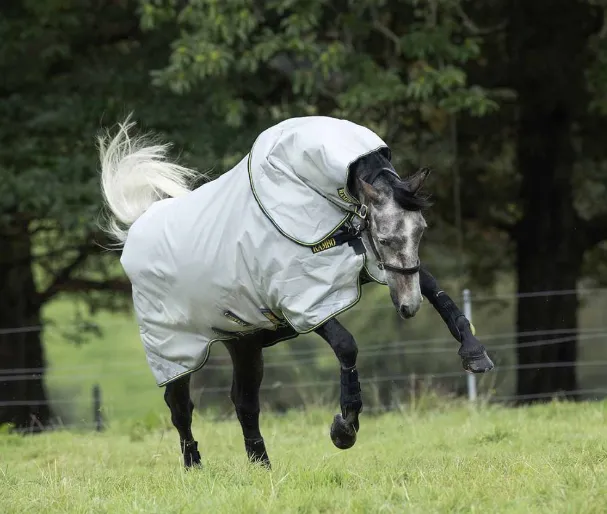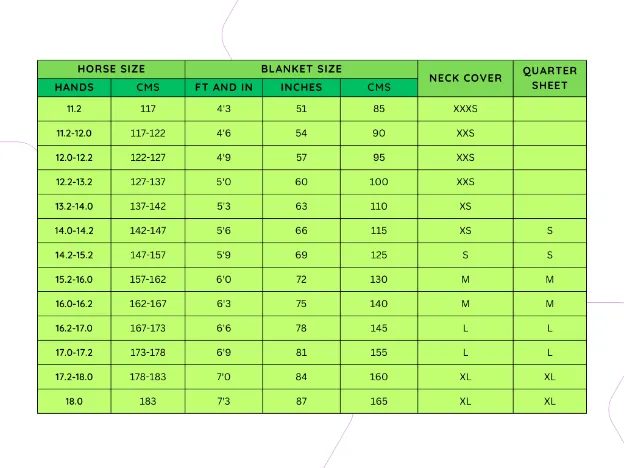The Only Horse Blanket Charts You'll Ever Need, How To Measure And Other Tips

-
Complete Horse Blanket Guide
- How To Measure A Horse For A Blanket
- Denier Explained
- Horse Blanket Weights Explained
- Horse Blanket Size Chart
- What Horse Blankets To Use According To Temperature
- Other Tips For Purchasing Blankets
- Related Articles
New: Rider Confidence and Mindset
Complete Horse Blanket Guide
You could have the most expensive, nicest blanket on the market but if it's too small for your horse it's only good for wrapping around yourself during cold weather at the barn.
That's an easy trap to fall into if you see a cracking good deal on a blanket at your local tack store but an undersized blanket is a big no-no. It'll be uncomfortable on your horse, lead to rubbing or sores, and possibly cause your horse unnecessary stress.
Within reason, you can get away with a blanket that's a little oversized on your horse, especially if it's only one size up.
How To Measure A Horse For A Blanket
You'll only need two things to measure your horse for blanket size, a soft measuring tape, and ideally a second person.
Stand your horse on the most level ground available and have them stand as close to square as you can.
Using the soft tape measure place it in the center of your horse's chest, right at the base of their neck, and measure to the top of the tail or where you want the blanket to end.
Make sure to place the tape at the widest part of your horse's shoulder and keep it nice and taut for an accurate measurement.
Next subtract 4in or 10cm, depending on which measurement scale you're using, and that's your horse's blanket size.
To be safe I advise taking two measurements or even three and finding the average number, if your horse is an in-between size go for the larger option.
Denier Explained
Denier is a unit of measurement used to describe the thickness or weight of a fabric. In the context of horse blankets, denier refers to the thickness of the outer shell material of the blanket. The higher the denier, the thicker and more durable the material is.
Horse blankets are available in a range of deniers, with the most common being 600D, 1200D, and 1680D. A 600D blanket is lightweight and suitable for mild weather conditions, while a 1200D or 1680D blanket is heavier and more durable, making it suitable for harsher weather conditions or for horses that are hard on their blankets.
Horse Blanket Weights Explained
The weight of a horse blanket refers to the amount of insulation or fill material in the blanket, which is measured in grams per square meter (gsm) or ounces per square yard (oz/yd²).
Depending on the season, the climate, and your horse's individual needs, the weight of which horse blanket you choose can vary. Here are some common blanket weights and their recommended uses:
Lightweight blankets: These blankets typically have a fill weight of 100-200gsm (3-6oz/yd²) and are designed for use in mild weather or as a layering piece. They are ideal for horses that live in regions with mild winters or for use during spring and fall seasons.
Medium-weight blankets: These blankets typically have a fill weight of 200-300gsm (6-9oz/yd²) and are designed for use in colder weather. They provide more insulation than lightweight blankets and are ideal for horses that live in regions with cold winters or for use during winter months.
Heavyweight blankets: These blankets typically have a fill weight of 300-400gsm (9-12oz/yd²) or more and are designed for use when it's very cold. They provide maximum insulation and are ideal for horses that live in regions with harsh winters or for use during extreme winter conditions.
It's important to note that these are general guidelines, and the appropriate blanket weight for your horse may vary depending on factors such as the horse's age, breed, health, and activity level, and if they're clipped or not, as well as the weather conditions and the environment in which your horse is kept.
Horse Blanket Size Chart
I've put together a blanket chart that gives a general size in regard to horse/pony height. This is meant as a guide for a horse of average build so if yours is built wide, or is narrow for their height you might be best to take a measuring tape and follow the steps above before hitting the store.
What Horse Blankets To Use According To Temperature
Just for good measure, I thought I'd put together a little temperature scale. No matter the time of year we're always questioning what blanket is appropriate for the weather and temperature.
Other Tips For Purchasing Blankets
Try to buy the best blanket you can afford, as long as your horse doesn't shred blankets like my stallion does, a good quality blanket should last for years.
Pay close attention to a brand's typical fitting style, a Rambo turnout blanket will not fit the same as a Back On Track therapeutic mesh sheet.
When fitting a blanket to your horse make sure it sits in front of, and not on their withers.
Always ensure you have leg or tail straps, if using leg straps loop them rather than crossing.
Take good care of your blankets, even the top-quality waterproof ones must be re-waterproofed. Wash them regularly, the build-up of dirt and bacteria is unhealthy for your horse.
Consider purchasing a blanket liner, they're an extra layer of warmth if you hit very cold weather and they're useful to use with a rain sheet for those in-between spring temperatures.
Just like when choosing a winter coat for yourself, pay attention to whether a blanket is waterproof or water-resistant.
If a seemingly well-fitted blanket rubs your horse's shoulders, or your horse has sensitive skin, you might need to get them a shoulder guard.
Related Articles
Best Horse Blankets; My Top 10 Picks
Best Fly Sheets; Protect Your Horse This Summer
-
Complete Horse Blanket Guide
- How To Measure A Horse For A Blanket
- Denier Explained
- Horse Blanket Weights Explained
- Horse Blanket Size Chart
- What Horse Blankets To Use According To Temperature
- Other Tips For Purchasing Blankets
- Related Articles





